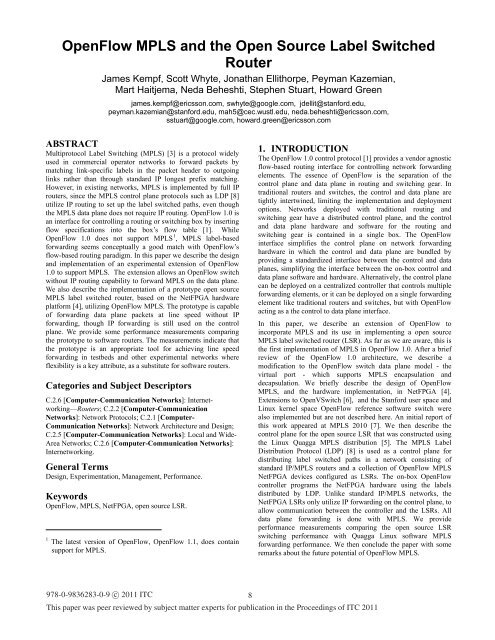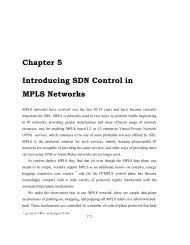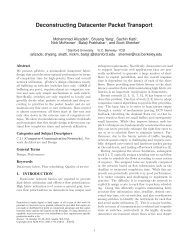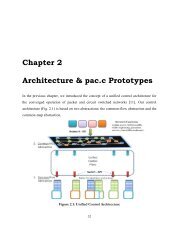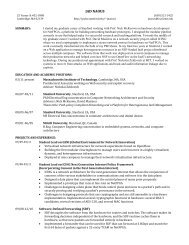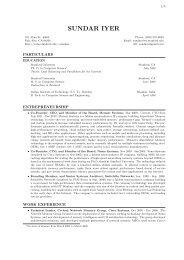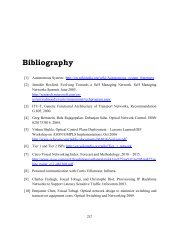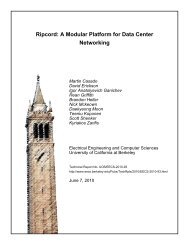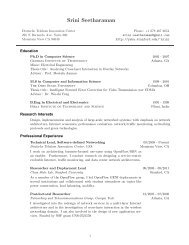OpenFlow MPLS and the Open Source Label Switched Router
OpenFlow MPLS and the Open Source Label Switched Router
OpenFlow MPLS and the Open Source Label Switched Router
You also want an ePaper? Increase the reach of your titles
YUMPU automatically turns print PDFs into web optimized ePapers that Google loves.
<strong><strong>Open</strong>Flow</strong> <strong>MPLS</strong> <strong>and</strong> <strong>the</strong> <strong>Open</strong> <strong>Source</strong> <strong>Label</strong> <strong>Switched</strong><strong>Router</strong>James Kempf, Scott Whyte, Jonathan Ellithorpe, Peyman Kazemian,Mart Haitjema, Neda Beheshti, Stephen Stuart, Howard Greenjames.kempf@ericsson.com, swhyte@google.com, jdellit@stanford.edu,peyman.kazemian@stanford.edu, mah5@cec.wustl.edu, neda.beheshti@ericsson.com,sstuart@google.com, howard.green@ericsson.comABSTRACTMultiprotocol <strong>Label</strong> Switching (<strong>MPLS</strong>) [3] is a protocol widelyused in commercial operator networks to forward packets bymatching link-specific labels in <strong>the</strong> packet header to outgoinglinks ra<strong>the</strong>r than through st<strong>and</strong>ard IP longest prefix matching.However, in existing networks, <strong>MPLS</strong> is implemented by full IProuters, since <strong>the</strong> <strong>MPLS</strong> control plane protocols such as LDP [8]utilize IP routing to set up <strong>the</strong> label switched paths, even though<strong>the</strong> <strong>MPLS</strong> data plane does not require IP routing. <strong><strong>Open</strong>Flow</strong> 1.0 isan interface for controlling a routing or switching box by insertingflow specifications into <strong>the</strong> box’s flow table [1]. While<strong><strong>Open</strong>Flow</strong> 1.0 does not support <strong>MPLS</strong> 1 , <strong>MPLS</strong> label-basedforwarding seems conceptually a good match with <strong><strong>Open</strong>Flow</strong>’sflow-based routing paradigm. In this paper we describe <strong>the</strong> design<strong>and</strong> implementation of an experimental extension of <strong><strong>Open</strong>Flow</strong>1.0 to support <strong>MPLS</strong>. The extension allows an <strong><strong>Open</strong>Flow</strong> switchwithout IP routing capability to forward <strong>MPLS</strong> on <strong>the</strong> data plane.We also describe <strong>the</strong> implementation of a prototype open source<strong>MPLS</strong> label switched router, based on <strong>the</strong> NetFPGA hardwareplatform [4], utilizing <strong><strong>Open</strong>Flow</strong> <strong>MPLS</strong>. The prototype is capableof forwarding data plane packets at line speed without IPforwarding, though IP forwarding is still used on <strong>the</strong> controlplane. We provide some performance measurements comparing<strong>the</strong> prototype to software routers. The measurements indicate that<strong>the</strong> prototype is an appropriate tool for achieving line speedforwarding in testbeds <strong>and</strong> o<strong>the</strong>r experimental networks whereflexibility is a key attribute, as a substitute for software routers.Categories <strong>and</strong> Subject DescriptorsC.2.6 [Computer-Communication Networks]: Internetworking—<strong>Router</strong>s;C.2.2 [Computer-CommunicationNetworks]: Network Protocols; C.2.1 [Computer-Communication Networks]: Network Architecture <strong>and</strong> Design;C.2.5 [Computer-Communication Networks]: Local <strong>and</strong> Wide-Area Networks; C.2.6 [Computer-Communication Networks]:Internetworking.General TermsDesign, Experimentation, Management, Performance.Keywords<strong><strong>Open</strong>Flow</strong>, <strong>MPLS</strong>, NetFPGA, open source LSR.1 The latest version of <strong><strong>Open</strong>Flow</strong>, <strong><strong>Open</strong>Flow</strong> 1.1, does containsupport for <strong>MPLS</strong>.1. INTRODUCTIONThe <strong><strong>Open</strong>Flow</strong> 1.0 control protocol [1] provides a vendor agnosticflow-based routing interface for controlling network forwardingelements. The essence of <strong><strong>Open</strong>Flow</strong> is <strong>the</strong> separation of <strong>the</strong>control plane <strong>and</strong> data plane in routing <strong>and</strong> switching gear. Intraditional routers <strong>and</strong> switches, <strong>the</strong> control <strong>and</strong> data plane aretightly intertwined, limiting <strong>the</strong> implementation <strong>and</strong> deploymentoptions. Networks deployed with traditional routing <strong>and</strong>switching gear have a distributed control plane, <strong>and</strong> <strong>the</strong> control<strong>and</strong> data plane hardware <strong>and</strong> software for <strong>the</strong> routing <strong>and</strong>switching gear is contained in a single box. The <strong><strong>Open</strong>Flow</strong>interface simplifies <strong>the</strong> control plane on network forwardinghardware in which <strong>the</strong> control <strong>and</strong> data plane are bundled byproviding a st<strong>and</strong>ardized interface between <strong>the</strong> control <strong>and</strong> dataplanes, simplifying <strong>the</strong> interface between <strong>the</strong> on-box control <strong>and</strong>data plane software <strong>and</strong> hardware. Alternatively, <strong>the</strong> control planecan be deployed on a centralized controller that controls multipleforwarding elements, or it can be deployed on a single forwardingelement like traditional routers <strong>and</strong> switches, but with <strong><strong>Open</strong>Flow</strong>acting as a <strong>the</strong> control to data plane interface.In this paper, we describe an extension of <strong><strong>Open</strong>Flow</strong> toincorporate <strong>MPLS</strong> <strong>and</strong> its use in implementing a open source<strong>MPLS</strong> label switched router (LSR). As far as we are aware, this is<strong>the</strong> first implementation of <strong>MPLS</strong> in <strong><strong>Open</strong>Flow</strong> 1.0. After a briefreview of <strong>the</strong> <strong><strong>Open</strong>Flow</strong> 1.0 architecture, we describe amodification to <strong>the</strong> <strong><strong>Open</strong>Flow</strong> switch data plane model - <strong>the</strong>virtual port - which supports <strong>MPLS</strong> encapsulation <strong>and</strong>decapsulation. We briefly describe <strong>the</strong> design of <strong><strong>Open</strong>Flow</strong><strong>MPLS</strong>, <strong>and</strong> <strong>the</strong> hardware implementation, in NetFPGA [4].Extensions to <strong>Open</strong>VSwitch [6], <strong>and</strong> <strong>the</strong> Stanford user space <strong>and</strong>Linux kernel space <strong><strong>Open</strong>Flow</strong> reference software switch werealso implemented but are not described here. An initial report ofthis work appeared at <strong>MPLS</strong> 2010 [7]. We <strong>the</strong>n describe <strong>the</strong>control plane for <strong>the</strong> open source LSR that was constructed using<strong>the</strong> Linux Quagga <strong>MPLS</strong> distribution [5]. The <strong>MPLS</strong> <strong>Label</strong>Distribution Protocol (LDP) [8] is used as a control plane fordistributing label switched paths in a network consisting ofst<strong>and</strong>ard IP/<strong>MPLS</strong> routers <strong>and</strong> a collection of <strong><strong>Open</strong>Flow</strong> <strong>MPLS</strong>NetFPGA devices configured as LSRs. The on-box <strong><strong>Open</strong>Flow</strong>controller programs <strong>the</strong> NetFPGA hardware using <strong>the</strong> labelsdistributed by LDP. Unlike st<strong>and</strong>ard IP/<strong>MPLS</strong> networks, <strong>the</strong>NetFPGA LSRs only utilize IP forwarding on <strong>the</strong> control plane, toallow communication between <strong>the</strong> controller <strong>and</strong> <strong>the</strong> LSRs. Alldata plane forwarding is done with <strong>MPLS</strong>. We provideperformance measurements comparing <strong>the</strong> open source LSRswitching performance with Quagga Linux software <strong>MPLS</strong>forwarding performance. We <strong>the</strong>n conclude <strong>the</strong> paper with someremarks about <strong>the</strong> future potential of <strong><strong>Open</strong>Flow</strong> <strong>MPLS</strong>.978-0-9836283-0-9 c○ 2011 ITC8This paper was peer reviewed by subject matter experts for publication in <strong>the</strong> Proceedings of ITC 2011
2. <strong><strong>Open</strong>Flow</strong> <strong>MPLS</strong> ArchitectureSince <strong><strong>Open</strong>Flow</strong> <strong>MPLS</strong> is built on top of <strong><strong>Open</strong>Flow</strong> 1.0, webriefly review <strong>the</strong> <strong><strong>Open</strong>Flow</strong> architecture here, <strong>and</strong> compare itwith previous control/data plane separation work beforedescribing <strong>the</strong> <strong><strong>Open</strong>Flow</strong> <strong>MPLS</strong> architecture.2.1 <strong><strong>Open</strong>Flow</strong> ArchitectureIn <strong>the</strong> canonical <strong><strong>Open</strong>Flow</strong> 1.0 architecture, <strong>the</strong> control plane innetwork switching <strong>and</strong> routing equipment is moved into aseparate controller. The controller communicates over a securechannel with <strong>the</strong> switches through <strong>the</strong> <strong><strong>Open</strong>Flow</strong> protocol.Software running on <strong>the</strong> controller “programs” <strong>the</strong> switches withflow specifications that control <strong>the</strong> routes of packets through <strong>the</strong>network. For routing purposes, <strong>the</strong> switches only need to run an<strong><strong>Open</strong>Flow</strong> control plane, considerably simplifying <strong>the</strong>irimplementation. An alternative architecture, shown in Fig. 1,utilizes <strong><strong>Open</strong>Flow</strong> as <strong>the</strong> interface between <strong>the</strong> control <strong>and</strong> dataplanes in <strong>the</strong> same box, while <strong>the</strong> control plane talks st<strong>and</strong>ard IProuting protocols with st<strong>and</strong>ard network routers <strong>and</strong> switches. Inthis architecture, <strong><strong>Open</strong>Flow</strong>’s flow-based routing designsimplifies <strong>the</strong> on-box control plane/data plane interface. The opensource LSR is designed according to <strong>the</strong> latter architecture.Fig. 1: Single Box <strong><strong>Open</strong>Flow</strong> Routing ArchitectureThe switch data plane in <strong><strong>Open</strong>Flow</strong> is modeled as a flow table inwhich <strong>the</strong>re are three columns: rules, actions, <strong>and</strong> counters. Therules column defines <strong>the</strong> flow. Rules are matched against <strong>the</strong>headers of incoming packets. If a rule matches, <strong>the</strong> actions from<strong>the</strong> action column are applied to <strong>the</strong> packet <strong>and</strong> <strong>the</strong> counters in <strong>the</strong>counter column are updated. If a packet matches multiple rules,<strong>the</strong> rule with <strong>the</strong> highest priority is applied. Each rule consists ofelements from a ten-tuple of header fields (see Fig. 2, from [9]) ora wild card ANY. The set of possible actions are: forward as if<strong><strong>Open</strong>Flow</strong> were not present (usually utilizing <strong>the</strong> E<strong>the</strong>rnetspanning tree route), forward to <strong>the</strong> control plane, forward out aspecific port, <strong>and</strong> modify various header fields (e.g. rewrite MACaddress, etc.).Fig. 2: Ten-tuple for Rule Matching2.2 Previous WorkMuch previous work exists in <strong>the</strong> area of control/data planeseparation for routing <strong>and</strong> switching. Most of <strong>the</strong> work isspecifically directed at implementing <strong>the</strong> control plane on aseparate box from <strong>the</strong> data plane.A st<strong>and</strong>ard for <strong>the</strong> separation of <strong>the</strong> control <strong>and</strong> data plane incircuit-switched networks is defined by RFC 3292 in <strong>the</strong>Generalized Switch Management Protocol (GSMP) [2]. GSMPmodels <strong>the</strong> network elements as cross-bar circuit switches.Particularly in optical circuit-switched networks, <strong>the</strong> switchesoften have physically separate control networks since it is oftennot possible to intercept <strong>the</strong> control packets from <strong>the</strong> opticallambdas, so separation of control <strong>and</strong> data plane becomes anecessity, GSMP provides a st<strong>and</strong>ardized protocol for thosesystems. Many vendors also have proprietary control protocols.The FORCES protocol [10] provides a st<strong>and</strong>ard framework forcontrolling data plane elements from a separate controller, butunlike <strong><strong>Open</strong>Flow</strong>, FORCES does not define a protocol forcontrolling a specific forwarding element. The FORCESforwarding element model [11] is quite general. <strong><strong>Open</strong>Flow</strong>, incontrast, defines a specific forwarding element model <strong>and</strong>protocol involving a flow table <strong>and</strong> ports. FORCES requires eachlogical forwarding block in <strong>the</strong> forwarding element to define itsown control protocol within <strong>the</strong> FORCES framework.The <strong><strong>Open</strong>Flow</strong> architecture is perhaps closest to <strong>the</strong> Clean Slate4D architecture defined by Greenberg, et. al. [12] The 4Darchitecture re-factors <strong>the</strong> network control, data, <strong>and</strong>management planes into 4 new planes (<strong>the</strong> “D”s in <strong>the</strong> name): <strong>the</strong>decision plane, <strong>the</strong> dissemination plane, <strong>the</strong> discovery plane, <strong>and</strong><strong>the</strong> data plane. The data plane is much as before, <strong>the</strong> decisionplane is <strong>the</strong> <strong><strong>Open</strong>Flow</strong> controller software, for example NOX[15], <strong>and</strong> <strong>the</strong> dissemination plane is provided by <strong>the</strong> <strong><strong>Open</strong>Flow</strong>protocol. The <strong><strong>Open</strong>Flow</strong> architecture defines no special supportfor discovery. In deployed <strong><strong>Open</strong>Flow</strong> systems, <strong>the</strong> controllerprovides this function through legacy protocols such as LLDP[18]. The Tesseract system [13] implements <strong>the</strong> 4D architecture.G<strong>MPLS</strong> [19] provides ano<strong>the</strong>r architectural approach tocontrol/data plane separation by extending <strong>MPLS</strong> to networksincluding circuit switches. G<strong>MPLS</strong> utilizes extensions ofintradomain routing protocols to perform topology discovery, <strong>and</strong>RSVP <strong>and</strong> LMP to establish label-switched paths betweennetwork elements. A network element under G<strong>MPLS</strong> control canei<strong>the</strong>r also perform forwarding, in which case G<strong>MPLS</strong> acts as <strong>the</strong>control plane for a st<strong>and</strong>ard switch or a router, or <strong>the</strong> networkelement can control separate forwarding elements through adifferent forwarding element control protocol. If <strong>the</strong> latter, aseparate switch control protocol, such as GSMP, controls <strong>the</strong>switches. G<strong>MPLS</strong> is restricted to transport networks, it does notprovide support for IP routing even though it uses IP intradomainrouting protocols for connectivity discovery.Proceedings of <strong>the</strong> 2011 23rd International Teletraffic Congress (ITC 2011) 9
There has also been work on control/data plane interfaces forconventional router implementations when <strong>the</strong> control <strong>and</strong> dataplane are implemented on <strong>the</strong> same box. The Click modular routertoolkit [14] defines interfaces between data plane components thatallow modular data planes to be built, but Click does not specifyany control plane interface. The control plane interface is hiddenbehind <strong>the</strong> individual Click elements. The Xorp router platform[15] defines a composable framework of router control planeprocesses, each of which is itself composed of modular processingstages. Xorp defines an interface to <strong>the</strong> data plane through <strong>the</strong>Forwarding Engine Abstraction (FEA). The FEA interface allowsdifferent types of data plane implementations, for example Clickor <strong>the</strong> NetBSD data plane, to be coupled to <strong>the</strong> control planewithout having to change <strong>the</strong> entire control plane software base.The Conman architecture [16] defines a modular data plane <strong>and</strong>control plane architecture with a well defined pipe interfacebetween <strong>the</strong> two. Our work differs from prior work in this area inthat we have taken an interface that was defined for simplifying<strong>and</strong> centralizing <strong>the</strong> control plane <strong>and</strong> instead implemented it as<strong>the</strong> control/data plane interface on a single box, providing a moreflexible deployment model for cases where a centralized controlplane is impractical.2.3 <strong><strong>Open</strong>Flow</strong> <strong>MPLS</strong>2.3.1 <strong><strong>Open</strong>Flow</strong> <strong>MPLS</strong> Design<strong>MPLS</strong> forms flow aggregations by modifying <strong>the</strong> packet header toinclude a label. The label identifies <strong>the</strong> packet as a member of aforwarding equivalence class (FEC). A FEC is an aggregatedgroup of flows that all receive <strong>the</strong> same forwarding treatment.A data plane <strong>MPLS</strong> node implements three header modificationoperations:Push: Push a new label onto <strong>the</strong> <strong>MPLS</strong> label stack, or, if<strong>the</strong>re is no stack currently, insert a label to form a new stack,Pop: Pop <strong>the</strong> top label off <strong>the</strong> <strong>MPLS</strong> label stack,Swap: Swap <strong>the</strong> top label on <strong>the</strong> stack for a new label.Fig. 3: <strong><strong>Open</strong>Flow</strong> Twelve-tuple for <strong>MPLS</strong> rulesThe <strong>MPLS</strong> label stack is inserted between <strong>the</strong> IP <strong>and</strong> MAC (Layer3 <strong>and</strong> Layer 2) headers in <strong>the</strong> packet. <strong>MPLS</strong> label stack entriesconsist of 32 bits, 20 of which form <strong>the</strong> actual label used inforwarding. The o<strong>the</strong>r bits indicate QoS treatment, top of stack,<strong>and</strong> time to live.The first modification required to <strong><strong>Open</strong>Flow</strong> is to increase <strong>the</strong>size of <strong>the</strong> tuple used for flow identification. In principle, <strong>the</strong> sizeof <strong>the</strong> <strong>MPLS</strong> label stack has no upper bound, but as a practicalmatter, most carrier transport networks use a maximum of twolabels: one label defining a service (such as VPN) <strong>and</strong> one labeldefining a transport tunnel. We <strong>the</strong>refore decided to extend <strong>the</strong>header tuple used for flow matching from 10 fields to 12. Only<strong>the</strong> actual 20 bit forwarding label is matched, <strong>the</strong> o<strong>the</strong>r bits are notincluded. Fig. 3 shows <strong>the</strong> 12 tuple.Fig. 4: Virtual Port Table <strong>and</strong> Virtual Port Table EntryThe next required modification was <strong>the</strong> addition of <strong>the</strong> <strong>MPLS</strong>header modification actions (push, pop, <strong>and</strong> swap) to <strong>the</strong> actionset executed when a rule matches. With <strong>the</strong> exception of limitedfield rewriting, <strong><strong>Open</strong>Flow</strong> 1.0 actions perform simple forwarding.The <strong>MPLS</strong> push <strong>and</strong> pop actions, in contrast, rewrite <strong>the</strong> headerby inserting fields into <strong>the</strong> header. Ra<strong>the</strong>r than inserting <strong>the</strong><strong>MPLS</strong> protocol actions into <strong>the</strong> basic <strong><strong>Open</strong>Flow</strong> packetprocessing pipeline, we chose instead to isolate <strong>the</strong>m using aabstraction called a virtual port. A virtual port is an abstractionmechanism that h<strong>and</strong>les complex protocol specific actionsrequiring header manipulation, <strong>the</strong>reby hiding <strong>the</strong> complexity of<strong>the</strong> implementation. This allows yet more complex headermanipulations to be implemented by composing <strong>the</strong>m out ofsimpler virtual port building blocks.Virtual ports can be hierarchically stacked to form processingchains on ei<strong>the</strong>r input or output. On output, virtual ports can beincluded in flow table actions just like physical ports. Virtualports are grouped toge<strong>the</strong>r with physical ports into a virtual porttable. Fig. 4 illustrates <strong>the</strong> virtual port table, toge<strong>the</strong>r with a tablerow. Each virtual port table row contains entries for <strong>the</strong> portnumber, <strong>the</strong> parent port, <strong>the</strong> actions to be performed by <strong>the</strong> virtualport, <strong>and</strong> statistics.The <strong>MPLS</strong> actions in <strong>the</strong> virtual port table consist of <strong>the</strong>following: push_mpls: Push a 32 bit label on <strong>the</strong> top of <strong>the</strong> <strong>MPLS</strong> labelstack , <strong>and</strong> copy <strong>the</strong> TTL <strong>and</strong> QoS bits from <strong>the</strong> IP header orprevious <strong>MPLS</strong> label,10 Proceedings of <strong>the</strong> 2011 23rd International Teletraffic Congress (ITC 2011)
pop_mpls: Pop <strong>the</strong> top label on <strong>the</strong> <strong>MPLS</strong> stack, <strong>and</strong> copy <strong>the</strong>TTL <strong>and</strong> QoS bits to <strong>the</strong> IP header or previous <strong>MPLS</strong> label,swap_mpls: Swap <strong>the</strong> 20 bit forwarding label on top of <strong>the</strong><strong>MPLS</strong> stack.decrement_ttl: Decrement <strong>the</strong> TTL <strong>and</strong> drop <strong>the</strong> packet if ithas expired. copy_bits: Copy <strong>the</strong> TTL <strong>and</strong> QoS bits to/from <strong>the</strong> IP headeror previous <strong>MPLS</strong> labelWe also added a counter to <strong>the</strong> <strong><strong>Open</strong>Flow</strong> statistics that isincremented every time a virtual port drops a packet due to <strong>the</strong>expiration of <strong>the</strong> TTL.The <strong><strong>Open</strong>Flow</strong> protocol was extended with <strong>the</strong> followingmessages to allow <strong>the</strong> controller to program label switched paths(LSPs) into <strong>the</strong> switches:vport_mod: Add or remove a virtual port number. Parametersare <strong>the</strong> parent port number, <strong>the</strong> virtual port number, <strong>and</strong> anarray of virtual port actions,vport_table_stats: Return statistics for <strong>the</strong> virtual port table.The statistics include maximum virtual ports supported by<strong>the</strong> switch, number of virtual ports in use, <strong>and</strong> <strong>the</strong> lookupcount, port match count, <strong>and</strong> chain match count. port_stats: The <strong><strong>Open</strong>Flow</strong> port_stats message applies tovirtual ports as well, but only <strong>the</strong> tx_bytes <strong>and</strong> tx_packetsfields are used.Finally, <strong>the</strong> <strong><strong>Open</strong>Flow</strong> switch_features_reply message wasmodified to include a bit indicating whe<strong>the</strong>r <strong>the</strong> switch supportsvirtual ports.2.3.2 NetFPGA ImplementationNetFPGA is a PCI card that contains a Virtex-2 Xilinx FPGA, 4Gigabit E<strong>the</strong>rnet ports, SRAM <strong>and</strong> DDR2 DRAM [4]. The boardallows researchers <strong>and</strong> students to build working prototypes ofline speed network hardware.The <strong>MPLS</strong> implementation extends <strong>the</strong> <strong><strong>Open</strong>Flow</strong> 10 tuple withtwo additional fields for <strong>MPLS</strong> labels, <strong>and</strong> adds virtual portfunctionality to support <strong>MPLS</strong>-specific actions. Fig. 5 shows <strong>the</strong>functional block diagram of <strong>the</strong> NetFPGA design. Ourimplementation of <strong><strong>Open</strong>Flow</strong> <strong>MPLS</strong> in NetFPGA is based on <strong>the</strong><strong><strong>Open</strong>Flow</strong> v0.89 reference implementation for NetFPGA.<strong><strong>Open</strong>Flow</strong> v0.89 differs slightly from <strong><strong>Open</strong>Flow</strong> 1.0 in that<strong><strong>Open</strong>Flow</strong> 1.0 supports VLAN type <strong>and</strong> IP ToS headers whereasv0.89 doesn’t. We used v0.89 because it was available at <strong>the</strong> time<strong>the</strong> work was done, since <strong>the</strong>se features aren’t necessary for <strong>the</strong>open source LSR <strong>and</strong> would have taken up valuable FPGAmemory (only 5% of NetFPGA Virtex-2 FPGA remained emptyafter implementing <strong>MPLS</strong> <strong><strong>Open</strong>Flow</strong>), we decided not to update.As packets arrive, a lookup key is created by concatenating <strong>the</strong> 12fields toge<strong>the</strong>r. The lookup key is used in parallel by two lookupengines, one performing exact match using two CRC hashfunctions <strong>and</strong> <strong>the</strong> o<strong>the</strong>r one doing wildcard match using a TCAM.Each of <strong>the</strong> exact <strong>and</strong> wildcard tables has 32 entries. The result of<strong>the</strong>se lookup operations is fed into a match arbiter that alwaysprefers an exact match to a wildcard match. The <strong><strong>Open</strong>Flow</strong>actions associated with <strong>the</strong> match are <strong>the</strong>n performed. If <strong>the</strong> actioninvolves a port, <strong>the</strong> port number is checked to see if <strong>the</strong> numbermatches a virtual port. If it does, <strong>the</strong> virtual port headermanipulation actions are performed.In <strong>the</strong> <strong><strong>Open</strong>Flow</strong> <strong>MPLS</strong> implementation, virtual ports implement<strong>the</strong> <strong>MPLS</strong> actions: push a new label, pop <strong>the</strong> top of <strong>the</strong> stacklabel, decrement <strong>the</strong> TTL, copy <strong>the</strong> TTL <strong>and</strong> copy <strong>the</strong> QoS bits.As an optimization, <strong>the</strong> swap operation is h<strong>and</strong>led by an<strong><strong>Open</strong>Flow</strong> rewrite action instead of in <strong>the</strong> virtual port. If <strong>the</strong>copy_bits action is performed during a push operation, it copies<strong>the</strong> TTL/QoS bits from previous <strong>MPLS</strong> label, <strong>and</strong> if it is done aspart of pop operation, <strong>the</strong> TTL/QoS bits of current label arecopied to <strong>the</strong> previous label. If only one <strong>MPLS</strong> label exists, IPTTL or IP ToS is <strong>the</strong> source or target instead. The decrement_ttlaction decrements <strong>the</strong> TTL value for <strong>the</strong> top of <strong>the</strong> stack label <strong>and</strong>drops <strong>the</strong> packet when <strong>the</strong> label value hits zero. To decrement <strong>the</strong><strong>MPLS</strong> TTL, without any push/pop operation or as part of a swapaction, <strong>the</strong> packet is forwarded to a pop virtual port with <strong>the</strong> pop<strong>and</strong> copy TTL/QoS functionality disabled.Virtual ports can be concatenated toge<strong>the</strong>r for up to two layers toperform two push or two pop operations in one NetFPGA card.The last virtual port in <strong>the</strong> chain forwards <strong>the</strong> packet to a physicalport on output, or <strong>the</strong> first virtual port accepts a packet from aphysical port on input.Fig. 5: <strong><strong>Open</strong>Flow</strong>-<strong>MPLS</strong> on NetFPGA Block DiagramThe last 8 positions in <strong>the</strong> wildcard table are always filled bydefault entries to h<strong>and</strong>le forwarding unmatched packets to <strong>the</strong>control plane. For each of <strong>the</strong> 4 NetFPGA ports, <strong>the</strong>re is one entryat <strong>the</strong> bottom of <strong>the</strong> wildcard table that has everything except anincoming port wildcarded. If a packet doesn’t match any o<strong>the</strong>rentry in <strong>the</strong> table, it will at least match that default entry <strong>and</strong> isforwarded to <strong>the</strong> DMA port corresponding to its input port. Thepacket is <strong>the</strong>n received by <strong>the</strong> <strong><strong>Open</strong>Flow</strong> kernel module runningon <strong>the</strong> host machine <strong>and</strong> is forwarded to <strong>the</strong> control plane.Similarly, packets coming from <strong>the</strong> control plane, are sent out ona DMA port by <strong>the</strong> <strong><strong>Open</strong>Flow</strong> kernel module, <strong>and</strong> are received byNetFPGA. There are 4 default rules in <strong>the</strong> wildcard table thatmatch on <strong>the</strong> packets coming from each of <strong>the</strong> 4 DMA ports <strong>and</strong>forward <strong>the</strong>m to corresponding output port.Proceedings of <strong>the</strong> 2011 23rd International Teletraffic Congress (ITC 2011) 11
3. <strong>Open</strong> <strong>Source</strong> <strong>Label</strong> <strong>Switched</strong> <strong>Router</strong>3.1 <strong><strong>Open</strong>Flow</strong>-<strong>MPLS</strong> LDP Control PlaneAs a demonstration of <strong><strong>Open</strong>Flow</strong> <strong>MPLS</strong>, we built a low-cost labelswitched router (LSR) consisting of a NetFPGA board running<strong><strong>Open</strong>Flow</strong> <strong>MPLS</strong> in a PC running <strong>the</strong> Linux <strong><strong>Open</strong>Flow</strong> driver,<strong>and</strong> <strong>the</strong> Quagga open source routing stack, including Quagga LDP<strong>and</strong> <strong>MPLS</strong> Linux [22]. In this model, <strong>the</strong> <strong><strong>Open</strong>Flow</strong> controllerruns on <strong>the</strong> same box as <strong>the</strong> NetFPGA LSR <strong>and</strong> acts as <strong>the</strong> controlplane only for <strong>the</strong> NetFPGA on <strong>the</strong> box as is <strong>the</strong> case in st<strong>and</strong>ardrouters <strong>and</strong> switches, in contrast to <strong>the</strong> canonical <strong><strong>Open</strong>Flow</strong>model discussed in Section 2.1. Fig. 6 contains a block diagram of<strong>the</strong> open source LSR. The entire bill of materials for <strong>the</strong> opensource LSR was around $2000.LDP, <strong>the</strong> <strong>Label</strong> Distribution Protocol [8], connects <strong>the</strong> opensource LSR with o<strong>the</strong>r forwarding elements in <strong>the</strong> network. LDPallows two devices to form an adjacency <strong>and</strong> establish labelbindings for label switched paths between <strong>the</strong>m. An LDPneighbor sends a LDP packet to <strong>the</strong> open source LSR in-b<strong>and</strong> onone of its connected interfaces. The open source LSR identifies<strong>the</strong> packet as part of a LDP flow <strong>and</strong> forwards it to <strong>the</strong> controlplane on <strong>the</strong> box, where it is sent to <strong>the</strong> Quagga LDP daemon. Asis <strong>the</strong> case for IP-<strong>MPLS</strong> routers, <strong>the</strong> open source LSR exchangesOSPF route information with external routers so that <strong>MPLS</strong> pathscan be established along known IP routes.against <strong>the</strong> <strong>MPLS</strong> Linux to demonstrate <strong>the</strong> performanceadvantage. The tests measured bidirectional throughput forpackets of 68 byes or 1504 bytes in length on a single port. Theresults are shown in Fig. 7. As should be clear from <strong>the</strong> figure,<strong>the</strong>re is 2 orders of magnitude difference in forwardingperformance between <strong>the</strong> NetFPGA <strong>and</strong> <strong>MPLS</strong> Linux. Inaddition, <strong>the</strong> performance of <strong>the</strong> NetFPGA LSR was constantregardless of packet size, whereas <strong>the</strong> performance of <strong>MPLS</strong>Linux decreased for smaller packets.The NetFPGA was able to maintain line speed performance up to3 ports, but scaled down to 6 Giga packets/second at 4 ports. Thislimitation had nothing to do with <strong>the</strong> <strong>MPLS</strong> implementation, o<strong>the</strong>rNetFPGA applications exhibit <strong>the</strong> same performance profile. Notethat many carefully coded <strong>and</strong> highly optimized software routersare able to achieve much better performance than <strong>MPLS</strong> Linuxexhibited in this study, but our objective here is not to compare<strong>the</strong> best software router with hardware, but ra<strong>the</strong>r to show <strong>the</strong>open source LSR provides good, reasonably scalable performancein comparison with a widely available, off <strong>the</strong> shelf softwareimplementation.120010001000 1000Megabits/Second800600400open source LSRmpls-linux20001001068 Bytes 1504 BytesPacket SizeFig. 6: <strong>Open</strong> source LSR Block DiagramThe LDP Daemon maintains <strong>and</strong> builds a normal LDP adjacency.Once LDP has formed an adjacency <strong>and</strong> completed a labelbinding, it updates <strong>the</strong> kernel <strong>MPLS</strong> LFIB with <strong>the</strong> correspondinglabel information. The LSP Synchronizer is a user level daemonthat polls <strong>the</strong> <strong>MPLS</strong> LFIB in <strong>the</strong> kernel periodically for changes,<strong>and</strong> when it detects a change it pushes a an <strong><strong>Open</strong>Flow</strong> flowmodification into <strong>the</strong> NetFPGA, enabling data plane packetsreceived with those labels to be forwarded correctly in hardware.3.2 Performance Measurements <strong>and</strong>Interoperability VerificationThe open source LSR is primarily a tool for prototyping newideas in networking, in that it offers line speed performance with<strong>the</strong> flexibility to change control plane <strong>and</strong> data plane software.Consequently, we performed a couple of simple performance testsFig. 7: Comparative Forwarding PerformanceWe also performed a test to verify that <strong>the</strong> open source LSR couldbe used in a network consisting of st<strong>and</strong>ard IP/<strong>MPLS</strong> routing gearrunning <strong>the</strong> st<strong>and</strong>ard IP/<strong>MPLS</strong> LDP/OSPF control plane. Thenetwork, shown in Fig. 8, consisted of two st<strong>and</strong>ard IP/<strong>MPLS</strong>routers, <strong>the</strong> SmartEdge100 [20] <strong>and</strong> <strong>the</strong> Juniper M10. All deviceswere running OSPF <strong>and</strong> LDP. The open source LSR was able toexchange OSPF <strong>and</strong> LDP messages with <strong>the</strong> IP/<strong>MPLS</strong> routers toset up LSPs through <strong>the</strong> network.Finally, we set up a test network to verify that it is possible toperform <strong>MPLS</strong> forwarding within a core network withoutrequiring iBGP. The core test network is shown in Fig. 9. Again,all devices speak OSPF <strong>and</strong> LDP. Two Juniper M10 routersfunction as label edge routers (LERs) <strong>and</strong> speak iBGP. The iBGPpackets are routed through <strong>the</strong> network of open source LSRs. Twohosts serve as sources <strong>and</strong> destinations of traffic. The LERs push<strong>and</strong> pop <strong>MPLS</strong> labels onto/off of <strong>the</strong> host traffic packets to routethrough <strong>the</strong> open source LSR core. Note that while <strong><strong>Open</strong>Flow</strong><strong>MPLS</strong> is designed to allow an <strong><strong>Open</strong>Flow</strong> <strong>MPLS</strong> switch to act asan LER too, in this case, we wanted to use <strong>the</strong> M10s to12 Proceedings of <strong>the</strong> 2011 23rd International Teletraffic Congress (ITC 2011)
demonstrate how <strong>the</strong> open source LSR could be used to set up aiBGP free core. The addition of a BGP module to <strong>the</strong> controlplane on <strong>the</strong> open source LSR would allow it to act as an LSR.Fig. 8: Interoperability Test Networka prototype iBGP free core network was set up that performs<strong>MPLS</strong> forwarding without <strong>the</strong> need for IP routing or iBGPspeakers. The network consisted of two hosts connected up torouters <strong>and</strong> a collection of open source LSRs. No interoperabilityproblems were found.Going forward, <strong>the</strong> success of <strong>MPLS</strong> in <strong><strong>Open</strong>Flow</strong> 1.0 has led to<strong>the</strong> incorporation of <strong>MPLS</strong> into <strong>the</strong> next version of <strong><strong>Open</strong>Flow</strong>,<strong><strong>Open</strong>Flow</strong> 1.1. Support for <strong>MPLS</strong> in <strong>the</strong> canonical <strong><strong>Open</strong>Flow</strong>centralized control plane model is necessary to utilize <strong>MPLS</strong> in<strong><strong>Open</strong>Flow</strong> 1.1. For <strong>the</strong> open source LSR model, <strong>the</strong> currentNetFPGA 1G only supports a realistic maximum of 32 flows,which is really too few for production use, even in a small campustestbed. The NetFPGA 10G [21] is a much better platform <strong>and</strong> is<strong>the</strong> target for future work. In addition, a port to NetBSD isplanned, since <strong>the</strong> <strong>MPLS</strong> implementation in NetBSD is morestable. Code for <strong>the</strong> open source LSR is available athttp://code.google.com/p/opensource-lsr.5. ACKNOWLEDGMENTSThe authors would like to thank Andre Khan for his foundingcontribution during <strong>the</strong> initial phases of <strong>the</strong> design, <strong>and</strong> NickMcKeown for his helpful direction during <strong>the</strong> design of <strong>the</strong> virtualport abstraction.Fig. 9: Core Interoperability Test Network4. Summary <strong>and</strong> ConclusionsIn this paper, we described an extension of <strong>the</strong> <strong><strong>Open</strong>Flow</strong>forwarding element control interface <strong>and</strong> model to include <strong>MPLS</strong>.The extension involves modifying <strong>the</strong> <strong><strong>Open</strong>Flow</strong> flow tableentries to include two <strong>MPLS</strong> labels <strong>and</strong> defining an extension of<strong>the</strong> <strong><strong>Open</strong>Flow</strong> port model to allow definition of virtual ports. Thevirtual ports implement <strong>the</strong> <strong>MPLS</strong> per packet processingoperations. An extension to <strong>the</strong> <strong><strong>Open</strong>Flow</strong> protocol allows <strong>the</strong>controller to program <strong>the</strong> <strong><strong>Open</strong>Flow</strong> <strong>MPLS</strong> forwarding element tomatch <strong>and</strong> process <strong>MPLS</strong> flows.The extension to <strong><strong>Open</strong>Flow</strong> was implemented on <strong>Open</strong>VSwitch,<strong>the</strong> Stanford reference software switch (both user <strong>and</strong> kernelmodules), <strong>and</strong> on <strong>the</strong> NetFPGA hardware. The NetFPGAimplementation supports up to 2 virtual ports for <strong>MPLS</strong>. Ademonstration system, <strong>the</strong> open source LSR, was built using<strong><strong>Open</strong>Flow</strong> as <strong>the</strong> control/data plane interface for a NetFPGArunning on <strong>the</strong> same PC as <strong>the</strong> control plane. This use of<strong><strong>Open</strong>Flow</strong> is in contrast to <strong>the</strong> canonical architecture in which awhole network of switches is controlled by one <strong><strong>Open</strong>Flow</strong>controller.Some simple performance tests were run comparing <strong>the</strong> opensource LSR to <strong>MPLS</strong> Linux for prototyping purposes. The testsdemonstrated that <strong>the</strong> open source LSR could significantlyimprove <strong>the</strong> performance of forwarding in prototype networks.An interoperability demonstration system was built using <strong>the</strong>open source LSR <strong>and</strong> two st<strong>and</strong>ard Internet routers capable of<strong>MPLS</strong> routing. The routers exchange LDP with <strong>the</strong> open sourceLSRs <strong>and</strong> each o<strong>the</strong>r to set up LSPs through <strong>the</strong> network. Finally,6. REFERENCES[1] “<strong><strong>Open</strong>Flow</strong>: Enabling Innovation in Campus Networks”,McKeown, N., et. al., March, 2008,http://www.openflowswitch.org//documents/openflow-wplatest.pdf.[2] Doria, A., Hellstr<strong>and</strong>, F., Sundell, K., Worster, T., ”GeneralSwitch Management Protocol (GSMP)”, RFC 3292, June2002.[3] Rosen, E., Viswanathan, A., <strong>and</strong> Callon, R., “Multiprotocol<strong>Label</strong> Switching Architecture”, RFC 3031, InternetEngineering Task Force, January, 2001.[4] http://www.netfpga.org.[5] http://www.quagga.net.[6] http://openvswitch.org.[7] http://www.isocore.com/mpls2010/program/abstracts.htm#wed1_5.[8] Andersson, L., Minei, I., Thomas, B., “LDP Specification”,RFC 5036, Internet Engineering Task Force, October, 2007.[9] <strong><strong>Open</strong>Flow</strong> Switch Specification V1.0.0,http://www.openflowswitch.org/documents/openflow-specv1.0.0.pdf.[10] Doria, A., Ed., Salim, J., Ed., Haas, R., Ed., Khosravi, H.,Ed., <strong>and</strong> Wang, W., Ed., “Forwarding <strong>and</strong> Control ElementSeparation (ForCES) Protocol Specification”, RFC 5810,Internet Engineering Task Force, March 2010.[11] Halpern, J., <strong>and</strong> Salim, J., “ForCES Forwarding ElementModel”, RFC 5812, Internet Engineering Task Force, March2010.Proceedings of <strong>the</strong> 2011 23rd International Teletraffic Congress (ITC 2011) 13
[12] Greenberg, A. et. al., “A Clean Slate 4D Approach toNetwork Control <strong>and</strong> Management,” Proceedings of ACMSIGCOMM, 2005.[13] Yan, H., Maltz, D., Ng, E., Gogineni, H., Zhang, H., <strong>and</strong>Cai, Z., “Tesseract: A 4D Network Control Plane”,Proceedings of <strong>the</strong> 4th USENIX Symposium on NetworkedSystems Design & Implementation, pp. 369–382, March,2007.[14] Kohler, E., Morris, R., Chen, B., Jannotti, J., <strong>and</strong> Kasshoek,F., “The Click Modular <strong>Router</strong>”, Operating Systems Review,34(5), pp 217{231, December, 1999.[15] H<strong>and</strong>ley, M., Hodson, O., <strong>and</strong> Kohler, E., “XORP goals <strong>and</strong>architecture” , Proceedings of <strong>the</strong> ACM SIGCOMM HotTopics in Networking, 2002.[16] Ballani, H., <strong>and</strong> Francis, P., “CONMan: A Step TowardsNetwork Manageability”, Proceedings of <strong>the</strong> ACMSIGCOMM Workshop on Internet Network Management,September, 2006.[17] Gude, N., Koponen, T., Pettit, J., Pfaff, B., Casado, M.,McKeown, N., Shenker, S., “NOX: Towards an OperatingSystem for Networks”, Computer Communications Review,July, 2008.[18] IEEE st<strong>and</strong>ard 802.1ab, “802.1ab rev – Station <strong>and</strong> MediaAccess Control Connectivity Discovery”, September, 2009.[19] Farrel, A. ad Bryskin, I., G<strong>MPLS</strong>: Architecture <strong>and</strong>Applications, Morgan Kaufmann Publishers, Amsterdam,412pp., 2006.[20] http://www.ericsson.com/ourportfolio/networkareas/se100?nav=networkareacategory002%7Cfgb_101_504%7Cfgb_101_647.[21] http://netfpga.org/foswiki/NetFPGA/TenGig/Netfpga10gInitInfoSite.[22] http://sourceforge.net/apps/mediawiki/mplslinux/index.php?title=Main_Page.14 Proceedings of <strong>the</strong> 2011 23rd International Teletraffic Congress (ITC 2011)


